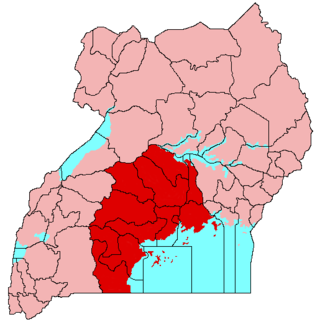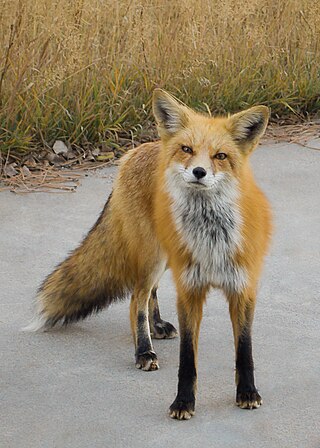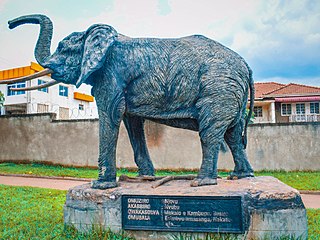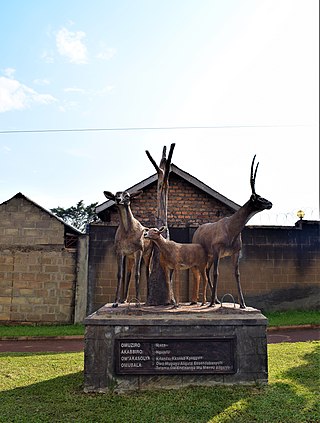
Nte Clan is among the many clans in the present day Buganda Kingdom. Nte is a Luganda word meaning Cow. The Head of the Nte Clan is called Katongole. Katongole came from Bunyoro Kingdom. The clan seat of the Nte Clan is located at Mulema. [1]

Nte Clan is among the many clans in the present day Buganda Kingdom. Nte is a Luganda word meaning Cow. The Head of the Nte Clan is called Katongole. Katongole came from Bunyoro Kingdom. The clan seat of the Nte Clan is located at Mulema. [1]
History has it that Katongole and his brother Lukyamuzi were royal princes in the Bunyoro Kitara Kingdom. Their elder brother was the Omukama(King) at that time, who they helped take the throne in the Princely wars by making sophisticated spears and arrows that were superior to those other groups. [2]
Katongole fell in love with the Omukama's favorite wife who then became pregnant. Upon the Omukama finding out, he became so furious that he ordered Katongole, his immediate family and whoever of the Princes/Princesses who side with him. Katongole and Lukyamuzi who were out looking for Matale stones(stones out of which metal was extracted for making spears and arrows), on their way home were informed of the Omukama's anger and the order for killing Katongole. Lukyamuzi was so close to Katongole, he decided to side with him making him to become a subject to the Omukama's harsh judgement. [2]
The two brothers headed towards Buganda Kingdom where an ambitious Kabaka in a young Kingdom was trying to surpass Bunyoro's might through Land Conquest wars. The Kabaka welcomed them and gave them land in Ssingo where they first settled. They were also appointed as makers of spears and other metallic equipment for use in wars. The plot and price on their heads in Bunyoro still remained, so they had to move frequently and often lived in hiding. Katongole was still anxious and afraid that someday Omukama may send men to find him and his family and kill them. Because of this fear, they further headed South deep into Buganda where they entered Teero Forest and stayed there for sometime. After leaving Teero, the Kabaka offered Katongole and his family land by the river near Teero on the Shores of Lake Nalubaale(Lake Victoria). They headed further to Buddu while looking for Amatale(rock out of which iron was extracted). They settled at Bijja now Bikira from where they could go towards the shores of Lake Victoria often to find the Amatale. The Amatale was found in abundance near the shores of Lake Victoria at a place called Mulema. [2]
Since Katongole was growing old, it was hard carrying rocks for long distances to Bijja, so he and his sons decided to settle at Mulema leaving Mutagubya and Nakana around Bijja. Mutagubya ended up at Nkenge where presently there is a seat of a Mutaba of the Nte Clan.
Katongole was laid to rest in Mulema and history says there is a big baobab tree that grew infront of his grave and still stands todate. Also it is said that Katongole's spear and ensinjo(tool used to cut hot metal) are buried at the base of this tree. This tree was used in many of the Bagabo ceremonies like the full moon celebrations. At the present date, no body is very sure of the exact spot of Katongole's grave. [2]
All people in the sub clans are headed by Katongole(Overall head of the Nte Clan). Each sub-clan has Bataka ba Masiga who report to Katongole and also each sub-clan observes its own rituals, customs and values. Nte Clan members are referred to Abagabo of Mulema. This name(Abagabo) originated from a long held practice of spiritual renewal which spans three days before and three nights after the full moon. [2]
Nte Clan has six well known common sub clans despite having many sub clans.
| Clan | Information |
|---|---|
| Clan (Ekika) | Nte |
| Totem (Akabiro) | Ŋŋaali |
| Clan Head (Omutaka) | Katongole Muggatta |
| Clan Seat (Obutaka) | Mulema, Buddu |
| Slogan (Omubala) |
|

Buganda is a Bantu kingdom within Uganda. The kingdom of the Baganda people, Buganda is the largest of the traditional kingdoms in present-day East Africa, consisting of Uganda's Central Region, including the Ugandan capital Kampala. The 14 million Baganda make up the largest Ugandan region, representing approximately 16% of Uganda's population.
The early history of Uganda comprises the history of Uganda before the territory that is today Uganda was made into a British protectorate at the end of the 19th century. Prior to this, the region was divided between several closely related kingdoms.

Bunyoro, also called Bunyoro-Kitara, is a traditional Bantu kingdom in Western Uganda. It was one of the most powerful kingdoms in Central and East Africa from the 13th century to the 19th century. It is ruled by the King (Omukama) of Bunyoro-Kitara. The current ruler is Solomon Iguru I, the 27th Omukama.

Daudi Cwa II was the 34th Kabaka of the Kingdom of Buganda from 1897 until 1939.

Busoga is a kingdom and one of four constitutional monarchies in present-day Uganda. The kingdom is a cultural institution which promotes popular participation and unity among the people of the region through development programs to improve their standard of living.
Chwa I Nabakka was Kabaka (King) of the Kingdom of Buganda. He reigned during the mid 14th century. He was the 2nd Kabaka of Buganda.
Kimera was Kabaka of the Kingdom of Buganda between 1374 and 1404. He was the third king of Buganda.
Rukirabasaija Omukama Oyo Nyimba Kabamba Iguru Rukidi IV, commonly known as King Oyo, is the reigning Omukama of Tooro, in Uganda. He was born on 16 April 1992 to King Patrick David Mathew Kaboyo Olimi III and Queen Best Kemigisa Kaboyo. Three and a half years later in 1995, Oyo ascended the throne and succeeded his father to become the 12th ruler of the 180-year-old Kingdom of Tooro.
Nakibinge Kagali was Kabaka (King) of the Kingdom of Buganda, between 1524 and 1554 AD. He was the 8th Kabaka of Buganda.

Muteesa I Mukaabya Walugembe Kayiira was the 30th Kabaka of the Kingdom of Buganda, from 1856 until 1884.
Rukirabasaija Kasunga Nyaika Kyebambe l was Omukama of the Tooro Kingdom, from 1872 until 1875. He was the fifth (5th) Omukama of Tooro.

The Baganda also called Waganda, are a Bantu ethnic group native to Buganda, a subnational kingdom within Uganda. Traditionally composed of 52 clans, the Baganda are the largest people of the Bantu ethnic group in Uganda, comprising 16.5 percent of the population at the time of the 2014 census.
Wasswa Chwamale Mwanga Winyi was a reigning monarch of Bunyoro-Kitara during the period circa 1300 AD. His chief palace was located at Kibulala, Ssingo, where his remains are buried today. When Prince Kalemeera of Buganda, the only son of Ssekabaka Chwa Nabakka, was exiled to Bunyoro, he took refuge at the palace of his paternal uncle, Winyi I at his palace in Kibulala. There he committed more transgressions, fathering Prince Kimera Walusimbi with Lady Wannyana, his uncle's chief wife. Prince Kimera later became the third Kabaka of Buganda.

Banyala, are a Bantu ethnic group native to Buganda, a subnational kingdom within Uganda. They stay in an area called Bugerere in Kayunga District,. They share a common ancestry with the Baruuli.

The Nvuma clan is believed to be one of the clans that were formed under Kabaka Kato Kintu. It is among the clans in Buganda Kingdom. Nvuma is a name in Luganda which means Pearl.

Nvubu Clan is among the many clans in the present day Buganda Kingdom. It is one of the clans that came to Buganda with Kintu. Nvubu is a Luganda name meaning Hippopotamus. The Nvubu Clan Head is Kayita.

Ntalaganya Clan is among the many clans in the present day Buganda Kingdom. It is one of the clans that were there before the reign of King Kintu. Ntalaganya is a Luganda name which means Blue Duiker. the ancestral home of the Ntalaganya Clan is in Kiwawu (Busujju).

Kibe Clan is among the many clans in Buganda Kingdom. Kibe is a Luganda name which means fox. The Kibe Clan existed during the reign of King Kintu. The Head of the Clan is called Muyige. The Clan seat for Muyige is found at Wantaayi in Kyaggwe(Present Mukono District). The Kibe Clan people first settled in Busujju before they went to Kyaggwe(presently Mukono district).

Njovu Clan is among the many clans in the present day Buganda Kingdom. All members belonging to the Buganda Kingdom belong to a clan each having a totem. Njovu is a Luganda word meaning Elephant.The Head of the Njovu Clan is Mukalo, he also is the founding father of the Clan.

Njaza Clan is among the many clans in the present day Buganda Kingdom.Njaza is a Luganda word meaning reedbuck. It is one of the five clans that are indigenous to Buganda before the coming of Kintu. The members of the five clans are referred to as the originals(Bannansangwa). The five other original clans were the Ffumbe, Ngeye, Lugave, and Nnyonyi Nnyange. They originated from Bunyoro and settled at Kiwawu in Busujju. From there, they moved and settled in the areas of Mabira Forest in Kyaggwe(currently Mukono District).